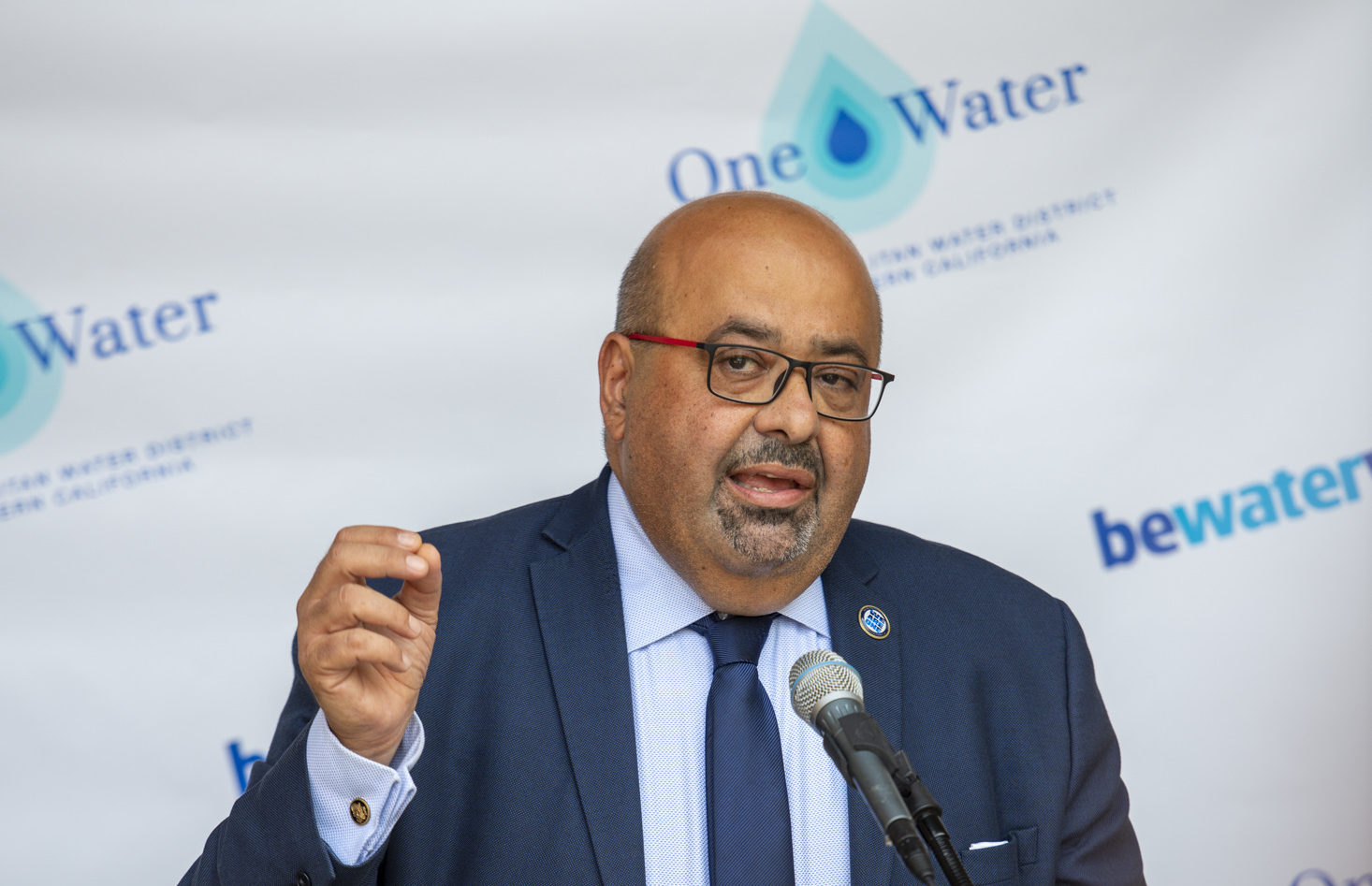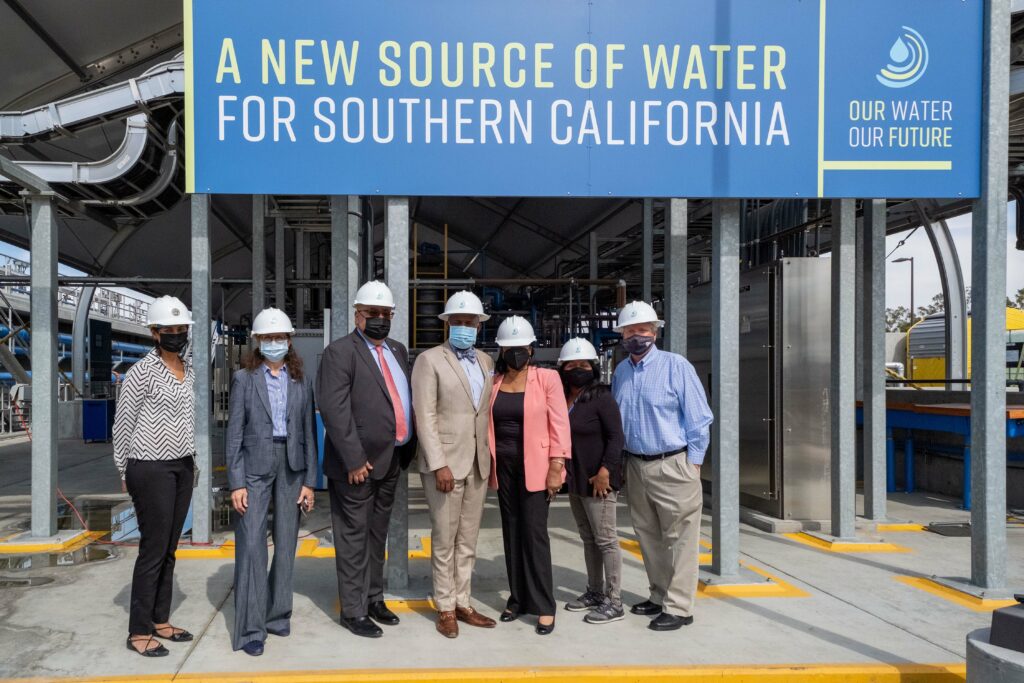
On October 17, 1972, the Edmonston Pumping Plant south of Bakersfield began lifting water drawn from the Delta up and over the Tehachapi Mountains toward southern California cities. That moment created a statewide water network stretching from the Trinity Alps to the Mexican border. It also made the Southland’s great umbrella water agency, the Metropolitan Water District of Southern California, an intimate partner and massive player in northern California water affairs.
Since that day, many in the north have seen “the Met” as a kind of colonial power, both far away and threateningly present. It pays a large share of the cost of the State Water Project. It owns lands in the Delta. It underwrites research. It often seems to determine the course of government policy. Few outside its sprawling boundaries (and maybe not so many inside them) really know much about it.
On June 9, the district’s 38-member board selected a new General Manager not of the traditional mold: Adel Hagekhalil. Hagekhalil is of course an engineer—that’s a given. He is also an immigrant who arrived from Lebanon in 1984 with, he says, two bags to his name. His skills and passion led him through a series of jobs under five LA mayors that would not, ordinarily, seem to groom him for the Met. He served a stint as director of StreetsLA; he spent almost a decade as assistant director of the Los Angeles Bureau of Sanitation. In that role he headed up the City’s effort to plan for “One Water,” the trending (and inevitable) idea that all waters—local or imported, hidden underground or flashing in the sun, roaring in flood or trickling in drought, flushed down toilets or pulled from mountain streams, irrigating farms or supporting fish—must be thought of and managed as aspects of one precious resource.

JH: As a northern Californian, I’m used to talking to people who look at the Met, and at Southern California in general, as it were, through the wrong end of a telescope. I rather frequently find myself in the position of saying no, no, they’re doing better than we are in this or that aspect.
AH: The folks in Southern California make me proud in terms of the amount of work they’ve done in conservation. People should know that we are using the same amount of water we were using 30 years ago with 5 million more people in our service area. 20 years ago, when Met projected how much water we have to import into our region, it was 3.2 million acre feet of water per year. Right now, we’re at about 1.5 million acre feet per year. Imagine today, if we had to import 3.2 million acre feet of water, there’s no way that we’d have it. Lake Mead doesn’t have it and Northern California doesn’t have it.
JH: Explain your metaphor of “the fourth aqueduct.”
AH: What let us grow in Southern California is that we have been able to bring water from three different locations via the LA Aqueduct (owned by the LA Department of Water and Power), the California Aqueduct, and the Colorado River Aqueduct. Today, we have a responsibility to build the fourth aqueduct, which is a not a pipeline. It’s a mixture of conservation, recycling, reuse, and all that coming together, resiliency, storage, all this that we need to invest in.
JH: Can you give us an example of an obvious next step in water conservation?
AH: Getting rid of the non-functional turf. And maybe I believe we can really ban it completely from the future here. If nobody is touching it, no human being and no animal is touching that turf, it shouldn’t be there, and we should put something more sustainable in its place.
JH: Why is interconnecting local water systems important?
AH: We have parts of our region that are still dependent 100% on the State Water Project. And that’s not acceptable. We are working hard to replumb our system to ensure that we can move water to where the demand is. During the One Water LA, we worked on moving wastewater from parts of the San Fernando Valley, on the east side to the west side, so we can treat it and recharge it in the San Fernando aquifers.
JH: That’s indirect recycling, in which the treated water spends time in the aquifer and is treated again on withdrawal. Do you see direct potable reuse—putting highly purified wastewater right back into the system—as having a role in the future?
AH: I believe it’s time. The largest cost for recycled water and reuse is conveyance. And if there’s a way we can defuse that, and maybe directly connect our systems, without having to travel long distance to infiltrate into the ground, it will change the game and make it a lot more resilient. We have technology now to do direct potable reuse, we have technology to do the monitoring we need to do. We need to have 21st century thinking—that includes direct potable.
JH: How do these strategies affect disadvantaged communities?
AH: About half of the people that we serve are part of underserved communities. Some of the communities in South and East LA have their own groundwater basins. And if those groundwater basins become fouled, they have to go on imported water. So it defeats the purpose of reducing dependence on imported water. It makes the cost of water to these underserved communities higher because they’re going to get imported water instead of cheaper groundwater. So I have an interest—the state has an interest—everyone has an interest to ensure that people who are getting groundwater can keep on doing so. We have to keep the groundwater basins clean, keep them operating, and recharge them when we can.
JH: You suggest that the State, and even other Colorado River Basin states, benefit by helping to fund One Water strategies in southern California.
AH: My message is ‘we are one’ We need to work together, to help each other. So help me with my recycled water program, help me with my storage, help me with resolving the issue around conservation, especially for underserved communities. Because investing in Southern California is investing in the entire state, in the entire Southwest. Helping us build local supplies and water efficiency will reduce our demands on imported water from the Colorado River and northern Sierra. Southern Nevada Water Authority and the Central Arizona Project are partnering with us now on our Regional Recycled Water Program because they see a benefit to the region as a whole.
JH: The question of Delta conveyance is due to revive next year, with a new proposal for a tunnel to supplement or replace the current method of moving Sacramento River water to the pumps.
AH: I did a trip to the Northern California, visited Lake Oroville, visited the different areas around the State Water Project, visited the Bay-Delta. What really opened my eyes is how vulnerable the delta is. To earthquake, to sea water intrusion, to many things. We need to do something to move water around the Delta, in my view. Not more water, but adequate supplies. We need to figure that out together. It’s going to probably take a long time to even get to an agreed alternative and agreed project. But we’re investing in the planning effort and the discussion around it.
But, as we’re moving that in that direction, I don’t want to put my eggs all in one basket. I’m going in here and developing a local water supply. A portion of my service area is 100% dependent on the State Water Project right now. And that is not acceptable.
Is there something we can do in the interim, can we build storage right now upstream of the Delta and downstream of the Delta? That could be a good thing for the environment. Environmental storage of water to keep water cooled and discharged into the delta is critical. And also the same thing south of the Delta, can we create storage systems, whether underground or above ground, so we can have more water that we can use during conditions of drought?
I’m doing a trip in January to meet with the stakeholders along the Bay Delta, especially the environmental community, the tribes and the community who live in the Delta,and others, to understand their perspectives. I’m trying to meet as many people as I can, I’m talking to folks in San Joaquin Valley, I’m talking to my partners in the State Water Project and others. I need to really, hopefully, bring my openness and willingness to collaborate with people—and I will ask people this, you know, let’s try to figure out how we can work together and trust each other. We cannot keep fighting. Let’s not throw out the baby with the bathwater.
JH: You put a lot of emphasis on defusing conflict.
AH: I’m challenging everyone—which is the environmental community, the ag community, the state, everyone—to come together, and let’s work in collaboration, we can’t keep fighting, let’s agree on how to manage the future of water together. So the first thing I did here, as you know, we settled the lawsuit with Imperial Irrigation District. And I’m working on settling a lawsuit right now with the San Diego County Water Authority, which I’m hoping to get done soon.
JH: Resolving some of these old debates seems a tall order.
AH: You know, I ran the LA Marathon. I committed myself in 2005 for March 2006. When I signed up, I couldn’t run a mile or half a mile. And over a year, I ran the marathon in March 2006. I was 100 pounds lighter, fitter, I trained, worked hard, enrolled people around me to run with me. And it’s, it’s like committing to the future, right? We all have to commit to something that may seem impossible. But you believe in it, and you set a goal. So I believe in that analogy, because I don’t believe in litigation. I don’t believe in us fighting. I don’t believe in things that do not move us forward.
All photos courtesy Metropolitan Water District.